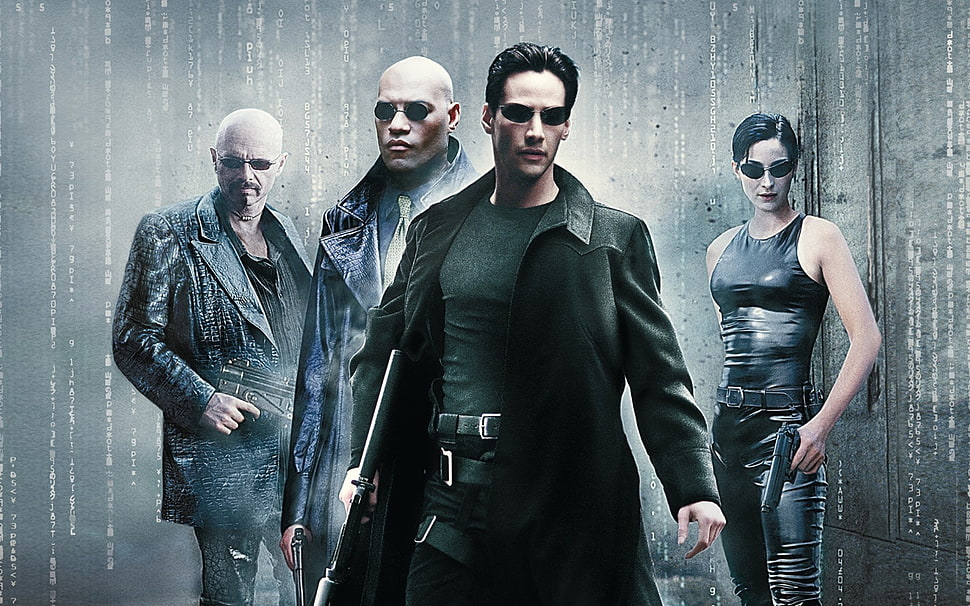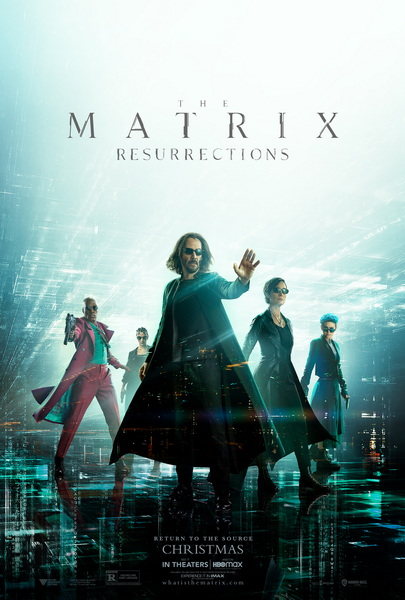Return of the Kings: In The Matrix Resurrections, Neo Reclaims His Title of Cinema’s Greatest Hero
By William Urbanski
The Matrix is the best movie ever made – far greater than The Godfather or even Citizen Kane. In addition, The Matrix trilogy, when considered as a whole, is the apotheosis of not only cinema, but of storytelling as a uniquely human phenomenon. If every Star Wars movie were combined with every single Star Trek book, comic book, TV show, and movie ever made, it would amount to no more than a stain on Neo’s underpants. To call The Matrix a mere cinematographic masterpiece would be an affront to the intellectual faculties of language and thought. It is the perfect movie, featuring the perfect cast, and each installment was released at the perfect time. The best chance humanity has to come closer together as a species is to study the lessons and implications of The Matrix films with the focus of a laser beam.
It is difficult to articulate the impact that The Matrix (the best movie ever made) and its sequels (Reloaded and Revolutions) have had on me, my world-view, and my personal development. That is why the announcement of a further addition to The Matrix canon filled me not only with excitement, but with a renewed belief in the inherent goodness of mankind. Instead of just reviewing The Matrix Resurrections, I would like to divide this article into two parts. The first part (written before I saw the new installment on Christmas Day) is a tribute to and celebration of the original Matrix trilogy and an explanation of why I expect Resurrections to be a pivotal moment in the history of multicellular life on Earth. The second part, written after watching the movie, will comprise some deep reflections on Resurrections and of the nature of reality itself.

Part One – The Matrix: Perfection in Movie-Making
Note: Spoilers ahead, but seriously, if you have not seen this movie by February, you are blowing it anyway.
While it would be extremely difficult to elucidate in a single article why The Matrix is the epitome of the motion picture industry, if Thomas Anderson (aka Neo, aka Keanu Reeves) has taught me anything, it is that anything is possible, so try I must. More than just a movie, The Matrix is a focal point of philosophical concepts, religious narratives, crucial societal themes, kung fu, ground-breaking special effects, and a love story far greater and more impactful than Romeo and Juliet and The Titanic combined. The only way to approach an even scanty appreciation of the beautiful amalgam that is The Matrix is to understand it as more than the sum of its parts.
It is no secret that The Matrix is built around major philosophical and religious concepts. Pluto’s cave allegory, as an obvious example, is mirrored by Neo’s escape from the perceived “real world.” When he awakens in his pod, the cords that provide life support break away, representing the casting away of physical and societal shackles. The religious themes (gratuitously borrowed from Christianity, but also from Buddhism and Taoism) are also not subtle but are tastefully presented in a way that does not patronize the audience. During a particularly well-known scene (for die-hard Matrix fans anyway), a character even refers to Thomas Anderson as his “savior” and “his own personal Jesus Christ.” Some of my personal favorite allusions are that a main villain in the first film is named “Cypher” (similar to “Lucifer”), and “Trinity” is a direct reference to the Holy Trinity. I could go on and on and on for days about all the brilliant, timely, and outright genius ways the story incorporates narratives and concepts central to the human experience, but the main takeaway here is that the rich tapestry of intellectual and religious ideas woven into the story is like nothing else before or after it.
At this point, it behooves me to address some of the controversy surrounding the sequels to the original Matrix film. Criticisms of The Matrix sequels are unfounded nonsense. In fact, it is my strong personal contention that they should be considered as a single movie that just happened to be broken up into three parts. What is hilarious is that while everyone loved the first movie because of the punch-kick kung fu and bullet-time explosions, the second and third ones came out and suddenly everyone was Siskel and Ebert, complaining that they were not as good as the first. Well, guess what? Nothing under the clear blue sky could ever have been as good as the original Matrix. What these ridiculous claims about the second and third movies really make me think of is, just like the love between Neo and Trinity, when you love something, you have to love all of it, not just the parts you happen to enjoy the most.
Before even seeing the new movie, I can say with absolute confidence that any attempt to extend this storyline is a gargantuan intellectual effort worthy of abundant and sincere praise. That the screenwriters of The Matrix did not receive a Nobel Prize for literature has Alfred Nobel turning over in his grave.

Part Two – The Matrix Resurrections
On a cold and clear Saturday afternoon that just happened to be Christmas Day, my wife and I strolled down to the lovely Geumnam-ro CGV. Walking downtown, seeing the streets filled with people, I could not help but think it was just like old times, or at least pre-pandemic times. Even the theater, which has been virtually empty during every movie I have been to over the last two years, had a good number of people in it – at least half full. Maybe it would have been better to avoid crowded areas with all the omicron-a-bing-bong hysteria, but I had a movie to see.
As for the movie itself, in the words of Keanu Reeves: “Whoa.”
A lot to unpack in this one. While I am still processing it, a couple of salient features are worth writing down while still fresh in my mind. Upon close reflection, at the end of The Matrix Revolutions, the Wachowski brothers (who incidentally are now the Wachowski sisters – a story for another day) had painted themselves into a corner by, you know, killing off the two main characters. No matter what, it was going to be very difficult to continue the canon without resorting to deus ex machina. While I did find Resurrections to be extremely self-referential, at times to the point of being self-congratulatory, folding the story back on itself was an extremely clever way to explain how Neo and Trinity were, you know, suddenly not dead anymore.
There were definitely some things in there I did not absolutely love, such as the ridiculous reappearance of the disheveled Merovingian and his henchmen. This guy had his time in the spotlight and should have walked off into the sunset while he had his chance. Also, the sentient robots that were helping the crew: What the hell was that all about? One of these sentient robots resembled a giant stick bug, and when a crew member gave him a fist bump, I actually cringed a little bit. These stupid robots reminded me of Jar Jar Binks of Star Wars notoriety: completely annoying. There are some other little nitpicky things in the film I did not care for, but let us be real: The Matrix has always pushed the envelope in terms of cinematic production and plot devices, and some of the stuff probably went a little over my head. As well, if the film had just given me what I wanted, that would not have been what I wanted.
Now, in the interest of writing a well-researched and balanced opinion article, I did read and watch a number of, shall we say, “unfavorable reviews” of Resurrections. Suffice to say, there were a number of iconoclasts who had some strong and negative opinions of the film, throwing around some big words such as “nonsensical” and “contradictory” when referring to the plot. Well, two things about that: First, on a philosophical note, many great thinkers have concluded that the ultimate nature of reality is inherently contradictory, and I think on a deep level, that is what was reflected in this movie. Second, what these game geeks and nerds conveniently forgot in their fancy-dancy YouTube videos and high-and-mighty reviews published in major international newspapers is the real reason people see movies. When people go to see a movie, they do not care about such things as the “story,” the “plot,” and the “dialogue.” What they want to see are the stars. If you’ve got stars, you’ve got a great movie. Given the extreme thirst for Matrix content, Lana Wachowski (the film’s director who used to be named “Larry”) could have made a movie of Carrie-Anne Moss reading the phone book and people still would have been lining up around the block to see it.
Conclusions
In the end, The Matrix franchise is more than just a bunch of movies: It embodies a generational zeitgeist. Each film is a work of art and a medium that blurs the lines between entertainment and philosophy, thought and experience, reality and, um, unreality. It follows that Resurrections is not just a movie: It is a time capsule that helps us travel back to a simpler period in our lives and reflect on just how far we have come and just how much the world has changed in the past twenty years.
In these crazy and uncertain times, what the world needs is more stories like The Matrix. Stories that make us laugh, love, and cry together. Stories that make us think. Stories that make us squirm ever so slightly in our easy chairs and sometimes even seize us, shake us, and snap us out of our trivial preoccupations. We need stories that remind us of a fundamental truth: There is no spoon.
Photograph by William Urbanski.
The Author
William Urbanski is the managing editor of the Gwangju News and an unapologetic Matrix fanboy.
Instagram @will_il_gatto




